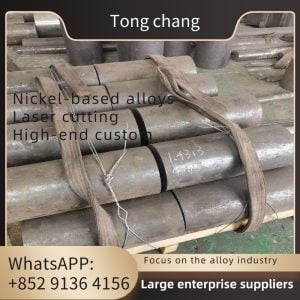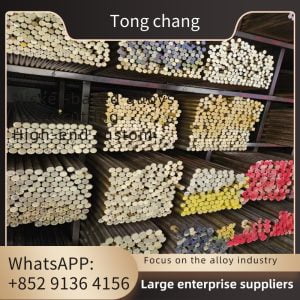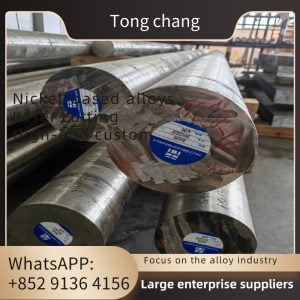| Type: | Studded Fin Tube | Tube Material: | Alloy Steel/stainless Steel/carbon Steel |
|---|---|---|---|
| Fin Material: | 11-13CR | Tube Length: | 18 Meters Max |
| Ends: | Bevled End/Plain End | Application: | Air Cooled Heat Exchangers (ACHE)/Process Heaters/Air Preheaters |
| High Light: | 11-13Cr Studed Fin Tube, Seamless Base Pipe Studed Fin Tube, Furnaces Studed Fin Tube | ||
Studed Fin Tube 11-13Cr Alloy steel Seamless Base Pipe Furnaces
Overview
Studded fin tubes are heat exchange tubes that have metal studs or pins attached to the outside surface of the tube. These studs or pins increase the surface area of the tube, allowing for improved heat transfer efficiency.
The studs are typically welded or brazed onto the tube surface and can be made from a variety of materials such as carbon steel, stainless steel, or copper. Studded fin tubes are commonly used in industries where high heat transfer rates are required, such as in oil refineries, chemical plants, and power plants.
The studded fins on the tube help to disrupt the airflow around the tube, creating turbulence and increasing heat transfer efficiency. This allows for more heat to be transferred from one fluid to another within the tube, making studded fin tubes a popular choice for heat exchangers in a wide range of applications.
Base Tube Material | Material Grade | Studs Material |
stainless steel stud tube, carbon steel stud pipe,alloy steel studded tube |
| Carbon steel: ASTM A510 grade 1005 to 1010. Stainless steel: AISI 304, 316, 410, 347, 321. ASTM A193 Grade: B6, B6X, B8, B8a, B8M, B8C. Cr-Mo alloy etc. |
Advantages of Fin Tube
Studded fin tubes offer several advantages compared to traditional smooth tubes or other types of heat exchange surfaces. Some of the key advantages of studded fin tubes include:
- 1. Increased heat transfer efficiency: The studs or pins on the surface of the tube create turbulence in the flow of fluids, enhancing heat transfer rates. This increased surface area allows for more efficient heat exchange, resulting in improved overall performance of heat exchangers and other systems.
- 2. Improved thermal performance: Studded fin tubes provide better thermal performance compared to smooth tubes, as they effectively increase the surface area available for heat transfer. This allows for better heat distribution and absorption, leading to more effective temperature regulation.
- 3. Reduction in fouling: The presence of studs or pins on the tube surface helps to disrupt the flow of fluids, reducing the buildup of fouling and deposits on the tube surfaces. This can result in improved system efficiency and reduced maintenance requirements.
- 4. Enhanced durability: Studded fin tubes are typically more robust and resistant to damage compared to smooth tubes. The studs provide additional support and protection to the tube surface, increasing the overall durability and longevity of the tube.
- 5. Versatility: Studded fin tubes can be made from a variety of materials, allowing for customization based on the specific requirements of the application. They are suitable for use in various industries and applications where efficient heat transfer is essential.
Overall, studded fin tubes offer a range of benefits that make them a popular choice for heat exchange applications in industries such as oil and gas, power generation, chemical processing, and more. Their ability to improve heat transfer efficiency, thermal performance, and durability make them a valuable component in various systems and equipment.
Application
Studded fin tubes are commonly used in a variety of equipment and applications where efficient heat transfer is essential. Some of the common equipment where studded fin tubes are used include:
- 1. Heat exchangers: Studded fin tubes are frequently used in heat exchangers to transfer heat between two fluids or gases. They are particularly well-suited for applications where high heat transfer rates are required.
- 2. Boilers: Studded fin tubes are used in boilers to increase the heat transfer efficiency and overall performance of the system. They help to enhance the heat absorption and heat distribution within the boiler.
- 3. Air coolers: Studded fin tubes are utilized in air coolers to improve the cooling efficiency of the system. They help to increase the surface area for heat transfer, allowing for more effective cooling of the air passing through the cooler.
- 4. Process heaters: Studded fin tubes are often employed in process heaters to optimize the heat transfer process. They assist in enhancing the efficiency of the heating system and improving overall performance.
- 5. Furnaces: Studded fin tubes are used in furnaces to enhance the heat transfer between the combustion gases and the material being heated. They help to increase the surface area for heat exchange, resulting in improved heating efficiency.
These are just a few examples of the equipment and applications where studded fin tubes are commonly used. Their versatility and effectiveness in optimizing heat transfer make them a valuable component in various industries and systems.








